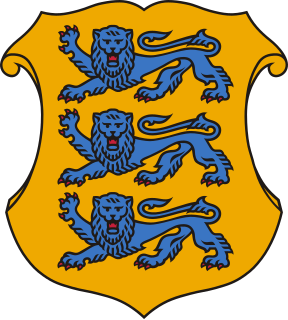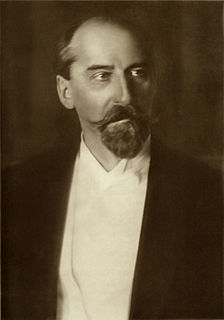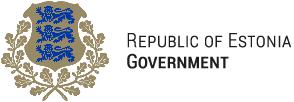The Second Dáil was Dáil Éireann as it convened from 16 August 1921 until 8 June 1922. From 1919 to 1922, Dáil Éireann was the revolutionary parliament of the self-proclaimed Irish Republic. The Second Dáil consisted of members elected at the 1921 elections, but with only members of Sinn Féin taking their seats. On 7 January 1922, it ratified the Anglo-Irish Treaty by 64 votes to 57 which ended the War of Independence and led to the establishment of the Irish Free State on 6 December 1922.
The Estonian Provincial Assembly was elected after the February Revolution in 1917 as the national diet of the Autonomous Governorate of Estonia in Russian Empire. On November 28, 1917, after the October Revolution the Assembly declared itself the sovereign power on Estonia and called for the elections of the Estonian Constituent Assembly. On the eve of the German occupation of Estonia in World War I the council elected the Estonian Salvation Committee and issued the Estonian Declaration of Independence on February 24, 1918.
A provisional government, also called an interim government or transitional government, is an emergency governmental authority set up to manage a political transition generally in the cases of new nations or following the collapse of the previous governing administration. Provisional governments are generally appointed, and frequently arise, either during or after civil or foreign wars.
The Third Dáil was both the Provisional Parliament or the Constituent Assembly of Southern Ireland from 9 August to 6 December 1922; and the lower house of the Oireachtas of the Irish Free State from 6 December 1922 until 9 August 1923.

Dáil Éireann, also called the Revolutionary Dáil, was the revolutionary, unicameral parliament of the Irish Republic from 1919 to 1922. The Dáil was first formed by 73 Sinn Féin MPs elected in the 1918 United Kingdom general election. Their manifesto refused to recognise the British parliament at Westminster and chose instead to establish an independent legislature in Dublin. The convention of the First Dáil coincided with the beginning of the War of Independence.

The Riigikogu is the unicameral parliament of Estonia. All important state-related questions pass through the Riigikogu. In addition to approving legislation, the Riigikogu appoints high officials, including the Prime Minister and Chief Justice of the Supreme Court, and elects the President. The Riigikogu also ratifies significant foreign treaties that impose military and proprietary obligations, bring about changes in law, etc.; approves the budget presented by the government as law and monitors the executive power.

The Parliament of Pakistan is the federal and supreme legislative body of Pakistan. It is a bicameral federal legislature that consists of the Senate as the upper house and the National Assembly, as the lower house. According to the constitution of Islamic Republic of Pakistan, the President of Pakistan is also a component of the Parliament. The National Assembly is elected for a five-year term on the basis of adult franchise and one-man one-vote. The tenure of a Member of the National Assembly is for the duration of the house, or sooner, in case the Member dies or resigns. The tenure of the National Assembly also comes to an end if dissolved on the advice of the Prime Minister or by the president in his discretion under the Constitution.

Jaan Tõnisson was an Estonian statesman, serving as the Prime Minister of Estonia twice during 1919 to 1920, as State Elder from 1927 to 1928 and in 1933, and as Foreign Minister of Estonia from 1931 to 1932.

Ganesh Vasudev Mavalankar popularly known as Dadasaheb was an independence activist, the President of the Central Legislative Assembly, then Speaker of the Constituent Assembly of India, and later the first Speaker of the Lok Sabha, the lower house of the Parliament of India. His son Purushottam Mavalankar was later elected to the Lok Sabha twice from Gujarat.
The Constituent Assembly of Lithuania was democratically elected in 1920 to draft and adopt the 1922 constitution of Lithuania.

The Constituent Assembly of Georgia was a national legislature of the Democratic Republic of Georgia which was elected in February 1919 to ratify the Act of Independence of Georgia and enact the Constitution of 1921. The assembly remained active until the Soviet Russian military intervention brought Georgia’s three-year independence to an end in March 1921.

Uttar Pradesh Legislative Assembly is the lower house of the bicameral legislature of the Indian state of Uttar Pradesh. It has a total of 403 members excluding one Anglo-Indian member who is nominated by the Governor. Till 1967, it had a strength of 431 members including one nominated Anglo-Indian member. According to the recommendation of the Delimitation Commission, which is appointed after every Census, it was revised to 426. After reorganization of the State on 9 November 2000, the strength of the Legislative Assembly has become 404 including one nominated member to represent the Anglo-Indian community. The Term of the Vidhan Sabha is five years unless dissolved earlier. The election is held on the principle of "one adult one vote".
The Ukrainian Constituent Assembly was a planned All-National Congress which was supposed to confirm the Constitution of the Ukrainian People's Republic and establish a new political system. The Assembly was supposed to be the supreme state power and elections to which were to be organized by the Central Council, which would hold its sessions between the meetings of the Assembly. The Assembly was suspended because of the Russian aggression in the Ukrainian–Soviet War that led to a proclamation of Ukrainian independence by the IV Universal.
The Estonian Labour Party was a political party in Estonia. It was formed in 1919 by a merger of the Radical Socialist Party and the Social Travaillist Party, and ceased to exist in 1932, when it merged with other centrist parties to form the National Centre Party. It was a member of government coalitions between 1919 and 1925, and again from 1927 until 1931.
The Christian People's Party was a political party in Estonia between 1919 and 1931.
Aleksei Sorokin was an Estonian lawyer and politician. He was regarded as one of the leading representatives of the Russian minority in Estonia during the interwar period.

The Constituent National Assembly, elected on 16 February 1919, was the first parliament in Austria's history to be elected by women and men in free and equal elections. On 4 March 1919 it replaced the Provisional National Assembly based on the 1911 Imperial Council elections. The National Assembly adopted the Habsburg Act, ratified the Treaty of Saint-Germain, which sealed the collapse of Cisleithania and demanded Austria's independence from Germany. In its last meeting on 1 October 1920, the assembly created the until-now lasting Constitution of Austria.














